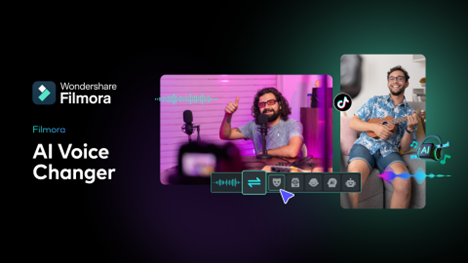Filmora’s AI voice changer stands proud as a modern tool for creating terrific multilingual voiceovers. It leverages advanced machine learning tools learning from existing models to regulate voice recordings seamlessly, it truly is extremely useful for multilingual duties. Here’s how this generation plays a crucial function:
Maintain Consistency
One of the primary challenges in multilingual voiceovers is retaining consistency in voice traits in the case of different languages. Traditional strategies regularly result in variations that can be jarring to the audience. Filmora’s AI voice changer addresses this trouble via:
- Uniform Voice Profiles: The AI analyzes the actual voice’s attributes, constituting pitch, tone, and timbre, and replicates these traits in the translated voiceovers. This ensures that the voice sounds regular, regardless of the language.
- Character Fidelity: For projects concerning character voices, the AI can keep the outstanding vocal traits. This is particularly beneficial in films, animations, and video games, wherein personal reputation is important.
- Seamless Transitions: When switching between languages inside a project, the AI guarantees that there are no abrupt adjustments in voice quality, providing an easy and coherent auditory experience.
Enhance Naturalness
Producing natural-sounding voiceovers is important for audience engagement. Poorly completed voiceovers can sound robotic or artificial, breaking the immersion. Filmora’s AI voice changer complements naturalness with the aid of way of:
- Deep Learning Models: The AI uses deep learning models skilled on huge datasets of several voice types and speech patterns. These models understand the nuances of human speech, allowing the AI to govern vocal attributes without dropping the natural quality of the voice.
- Adaptive Modifications: The AI adjusts vocal parameters in real-time, ensuring that modifications in pitch, tone, and timbre do not distort the voice. This adaptability results in voiceovers that sound real and keep the emotional impact of the original recording.
- Contextual Adjustments: The AI should make subtle modifications based totally on the context of the speech, which emphasizes high quality terms or phrases to form the linguistic and cultural nuances of the goal language.
Simplify the Process

Creating multilingual voiceovers historically entails a complicated and time taking way of recording, editing, and syncing. Filmora’s AI voice changer simplifies this workflow via the use of:
- Automated Voice Modulation: The AI automates the way of adjusting voice attributes, decreasing the need for manual tweaking. This speeds up the workflow and allows creators to focus on different factors of their tasks.
- Efficient Dubbing: For dubbing tasks, the AI can quickly adapt the authentic voice to the desired language without the need for a couple of voice actors. This not only saves time, moreover it reduces prices related to hiring and recording.
- User-Friendly Interface: Filmora’s intuitive interface makes it clean for creators to apply voice adjustments and customise settings. Even people with little or no technical experience can achieve professional-quality results.
- Real-Time Feedback: The AI presents real-time remarks at the adjustments, permitting creators to make immediate adjustments and make certain the voiceovers meet their preferred standards.
By leveraging the power of advany system learning, Filmora’s AI voice changer offers a strong solution for multilingual voiceovers. It ensures consistent, natural, and outstanding voice variations while simultaneously simplifying the editing process, making it a useful tool for content creators aiming to attain a variety of different language speaking audiences.
Benefits of Using Filmora’s AI Voice Changer for Multilingual Projects
Let’s take a look at the advantages of using AI voice changer feature of Filmora for Multilingual or translation projects.
Efficiency
Filmora’s AI voice changer automates and streamlines the technique of adapting voices for multiple languages, considerably reducing the effort and time required. Traditionally, creating multilingual voiceovers involves several ranges, including script translation, voice actor casting, recording, modifying, and synchronization. The AI handles voice modulation routinely, adjusting pitch, tone, and timbre to fit the goal language’s phonetic and acoustic properties.
Quality
Filmora’s AI voice changer promises exceptional, natural sounding voiceovers that preserve the original voice’s traits and readability. This is essential for keeping audience engagement and credibility. By the usage of deep learning models trained on diverse datasets, the AI replicates human speech nuances, resulting in voiceovers that sound proper and emotionally resonant.
Cost-Effective
Utilizing Filmora’s AI voice changer reduces the need for multiple voice actors for every language, saving costs associated with hiring and recording. The AI can adapt a voice actor’s recording to numerous languages, ending the need to hire multiple actors. By integrating those capabilities, Filmora’s AI voice changer no longer only complements the efficiency of multilingual voiceovers, additionally it also offers a powerful and noticeably flexible answer for content creators. This permits the production of professional-grade voiceovers that resonate with various audiences across distinct languages.
Conclusion
Filmora’s AI voice changer is an effective tool for content creators seeking to extend their reach to multilingual audiences. By leveraging superior AI technology, it simplifies the way of translating and adapting voices, ensuring splendid, natural-sounding voiceovers that resonate with several linguistic audiences. Whether you’re working on a movie, YouTube video, podcast, or company education material, Filmora’s AI voice changer permits you to create attractive content for viewers around the world.

 Join Daily Trust WhatsApp Community For Quick Access To News and Happenings Around You.
Join Daily Trust WhatsApp Community For Quick Access To News and Happenings Around You.


